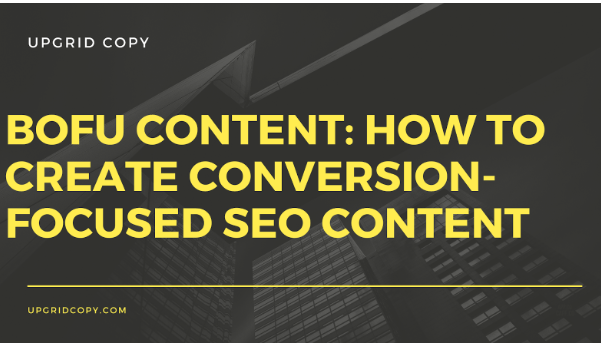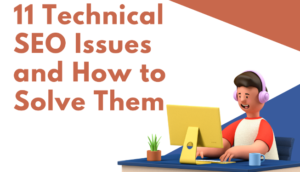What do 81% of consumers have in common? They conduct online research before buying. And according to research published by Think With Google, 51% of global shoppers say they use Search to research a purchase they plan to make online. So, what should these numbers mean for businesses?
It is simple; you need to have an online presence and rank higher on Google to attract customers and, importantly, make sales. But it isn’t that straightforward.
To achieve those two goals, you need to create content that meets users at every juncture of their customer journey and nurtures them to the last stage. The average customer spends 79 days gathering information before making a major purchase. During this window, they will likely go through a funnel from awareness and interest to consideration and conversion.
The most important stage for any business is the conversion stage, at the bottom of the funnel. This is where you get to convince the customer to make a purchase. It requires a conversion-focused content strategy. You will need more overtly persuasive content that can convince customers to choose your business.
This article will discuss how you can create SEO-Optimized botton of the funnel (BOFU) content that converts.
What is Bottom of the Funnel (BOFU) Content?
BoFu content refers to the type of content you create for prospects who have reached the lower stage of your marketing funnel. The customers at this stage are ready to take action, such as buying a product, downloading an app, ordering your service, or taking any action that completes your customer acquisition journey.
The funnel has three stages, top, middle, and bottom. The bottom is the narrowest and represents customers ready to make buying decisions. At this stage, your content must be able to convince the prospect to choose your business over your competitors.
Think of the BoFu stage as the closing stage. The other 2 stages have different purposes and all aim to push the prospects further down the funnel.
Top of the Funnel (ToFu) Content: This is content you use to attract customers and build awareness for your business. It generates the most leads, and at this stage, your goal is to inspire the prospects who have discovered your brand to move down the funnel.
Middle of the Funnel (MoFu) Content: Customers who make it to this stage are at the consideration stage. They want to learn more about your business and products/services. Therefore, your goal is to inform them by helping them understand their problem and hint at how you can help them solve it. While you can promote yourself here, you should focus more on building trust to inspire the prospect to move to the last stage.
Bottom of the Funnel (BoFu) Content: This is the conversion stage and comprises the most important pool of prospects. The hot and qualified leads. They are ready to take action, and your content should push them to. It needs to be persuasive and authoritative to push them over the edge. You need to show them why and how your product will offer the best solution for the pain points and how it’s better than competitors.
Why You Need Bottom of the Funnel Content
The main goal of content marketing and building a sales funnel is to nurture prospects and build trust so that you can convert them at the last stage. Your BoFu content needs to be able to do that. If your BoFu content can’t convince them to buy from you, you will be leaving money on the table, literally.
When done right, your BoFu content can help you:
- Establish your business as the best choice among available options
- Offer hot prospects the last pieces of information they need to make a purchase decision confidently
- Avoid content gaps and ensure your ToFu and MoFu content doesn’t go to waste and lose customers at the end of the funnel. Without BoFu, your funnel can be ineffective.
- Get a higher ROI due to the transactional nature of their search intent – Prospects are ready to buy at this stage.
- Communicate your unique selling propositions and separate yourself from competitors.
How to Create SEO-Optimized BoFu Content That Converts
If you want to generate leads and conversions for your business, organic traffic is one of the most valuable resources you can tap into. However, to consistently achieve these results with your BOFU content, you must focus on two critical factors: search engine optimization (SEO) and user engagement.
It’s not enough to simply rank high on search engine results pages (SERPs) if your content fails to provide value to your readers. Likewise, creating high-quality BOFU content that isn’t SEO-optimized won’t be seen by potential customers. That’s why it’s crucial to strike the right balance between the two. You need to know how to merge the two, i.e., Create SEO-optimized BoFu content that drives conversion.
Here’s how to do that.
Know Your Customers’ Pain Points
The first thing your need to do is create a buyer persona for your BOFU audience. Your customer has probably gone through the top stage, so you have data on them. The more data you have about your buyer’s journey, the better you can tailor your approach, address their pain points, and convert them.
In an ideal world, the best way to understand the customers’ pain points could be to ask them directly. But for most businesses, that could be impossible. However, they’re other steps you can take, including:
- Look for patterns in your customers’ journeys – You can monitor industry forums and your on-site search data to establish these patterns.
- Analyze your sales data and determine the questions customers will likely ask about your product/service when buying or after buying. You can get this info from your sales and customer care team.
- Conduct keyword research to understand the terms and phrases that potential customers use to search for solutions to their problems. (More on this below.)
Once you know your customer’s pain points, you can start creating your BoFu content by answering the following questions:
- What do they want?
- What do they hate?
- What are they lacking?
- How can I help them?
Target The Right BOFU Keywords
Once you know your user pain points, the next thing you need to know is the search terms they’re likely to use to find you. We’ve seen that BOFU content is the content optimized for the lower stage of the buying decision. Likewise, BOFU keywords are terms users search for at the end of their purchasing cycle.
If you optimize your BOFU keywords, you can develop SEO-focused conversion content.
The types of keywords are more commercial and generally address unique user needs. Therefore, to target this keyword, you need to create the following types of content:
- Comparison Content – At the end of the journey, customers might want to compare you to your competitors. You can take charge of the narrative if you do this yourself by creating comparison content like “brand vs. brand,” “brand alternatives,” and “brand competitors.”
- Review Content – Customers want to know your legitimacy. You should therefore ensure your BoFU content can show social proof. Consider case study content, leveraging social proof like video testimonials, and displaying your ratings from Google and TrustPilot on your content.
To find your BoFu keywords, you can research them using traditional methods. That includes:
- Using google autocomplete keyword suggestions.
- Using auto-complete tools like Topic Mojo and Answer The Public.
- Leveraging SERP features like “People Also Ask” and “related searches.”
- Analyzing your competitors’ keywords.
Know Your Competitors
They say you shouldn’t compare yourself to competitors. Still, regarding SEO and BOFU content, you need to know your SERP competitors, compare yourself against them, and outshine them. If you fail to do this, your content won’t reach the first page of Google, and you’ll struggle to get organic conversions.
Since you’ve established your BOFU keywords, you should analyze the SERPs for ranking content to see what you are up against. How well are they addressing users’ pain points, and what can you do better?
Targeting the search terms won’t be enough to steal your competitors’ place in the search engine, nor will they make the audience choose you. To do this, you need to write BoFu content to help users make buying decisions and rank higher by sticking to Google’s guidelines for “helpful content.”
Create E-E-A-T Content
For your BoFu content to rank and for users to find it helpful, it needs to follow Google’s guidelines on what helpful content is. And that requires sticking to E-E-A-T or Double E-A-T guidelines.
Let’s break down what this acronym means:
Experience – Your BoFu content should demonstrate first-hand experience with the subject matter. For instance, if your audience at the end of the funnel is interested in reading reviews, you should create verifiable product review content. This means not using stock or generic images or giving false reviews about products you haven’t tested.
Expertise – Your BoFu content is the most important in the funnel; therefore, you have no room to plant doubts in the mind of prospects. You should demonstrate a clear understanding and knowledge of the topic if you want to rank and convince customers to convert.
Authoritativeness – Your content needs to come from a reputable source. This requires that you distribute your BoFu content on the right websites. For instance, if you sell coffee machines, posting your content on an automotive website won’t bring you any customers.
Trust – Your BoFu content needs to build trust with the audience. At this stage, the customer is educated about their pain points and is looking for a solution. Therefore, you must be very transparent and ensure your share content is accurate.
If your BoFu content can satisfy this guideline, you can address your prospects’ pain points, improve your SEO, and increase your conversion rate.
Create Product-Led Content
At the end of the Funnel, customers are more interested in your business and products. You need to offer them content that goes in-depth into how your product will help them.
Creating product-led content doesn’t mean you need to go over the board and be very sale-sy. Rather, you need to perfectly weave your product into the content and show users how it can solve their problems.
To create product-centric content, you can use your product databases, user reviews, and other social proofs. For instance, you can tell prospects which industry leaders use your products. This can help you build trust.
To create product-led BoFu content, focus on your products’ use cases. Then follow it up with how it can help prospects. This strategy will kill doubts and confirm to your readers that your product will indeed help them.
One way of creating product-led content is by doing reviews and comparisons. If you take this path, remember to remain objective and don’t sell your products while trashing competitors. This might not sit well with prospects. Even if your products are superior, it’s better to focus on your USPs and recognize those of competitors.
Use Effective CTA
Once a user has read your content, you need to convert them. And that requires telling them the next step they should take using effective call-to-action messaging. Here’s how to do that:
- Use appropriate CTAs that are conversion driven – For instance, asking a user to download a whitepaper or case study might be less appropriate. Ask them to book a consultation or sign up for a free trial.
- Spread your CTAs across your webpage – This strategy can be useful if your customer decides to convert before reading your entire content.
- Use powerful visible CTAs that can solicit immediate actions – Consider making them visible and use a language that creates a sense of FOMO.
- Offer incentives – Offer promotions and freebies such as free demos, free consultations, or 50% discounts for new customers. Incorporate them in your CTAs to get the prospects more interested.
- Leverage exit intent popup with CTAs – This will help capture a BoFu prospect before they leave your website.
- Test your CTAs – Consider testing your CTAs until you find the one with the highest conversion.
Think Beyond Conversion
Businesses need to focus not just on conversion but on creating a holistic customer experience that addresses their users’ changing needs and pain points. This requires analyzing your content at the bottom of the funnel and ensuring it is always up-to-date and relevant.
It’s important to also focus on customer retention and upselling. Creating content that retains customers and persuades them to buy other products or services can turn one-time customers into lifelong brand loyalists and ambassadors.
Remember that the sales funnel doesn’t have to end after the conversion stage. Continuously engaging with your customers through high-quality content and personalized experiences can increase their loyalty and drive revenue growth for your business.





